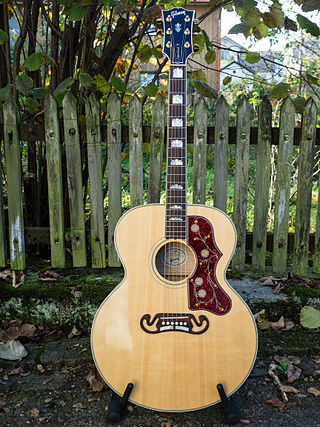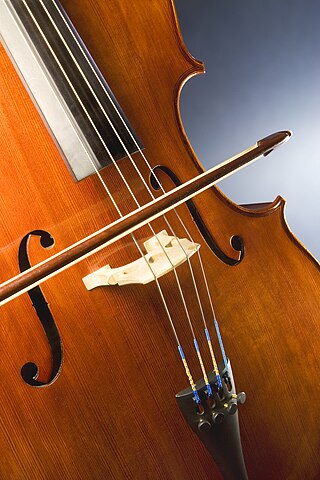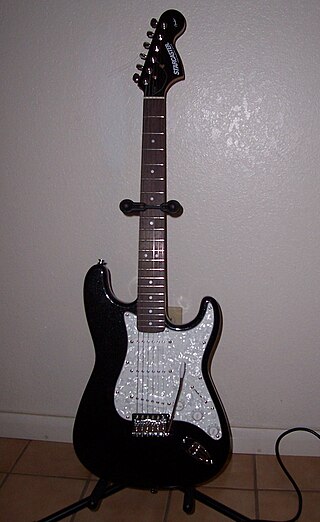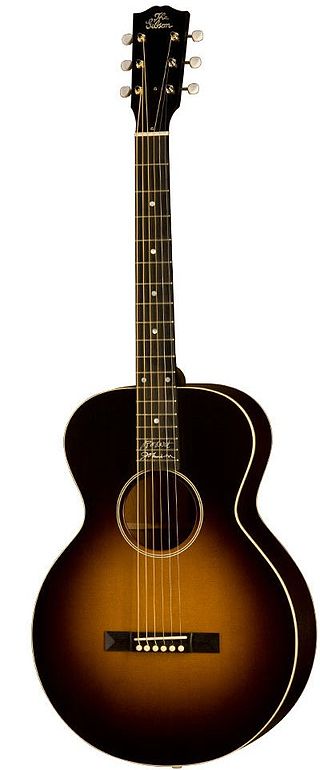
The steel-string acoustic guitar is a modern form of guitar that descends from the gut-strung Romantic guitar, but is strung with steel strings for a brighter, louder sound. Like the modern classical guitar, it is often referred to simply as an acoustic guitar, or sometimes as a folk guitar.

C.F. Martin & Company is an American guitar manufacturer established in 1833 by Christian Frederick Martin. It is highly respected for its acoustic guitars and is a leading manufacturer of flat top guitars. The company has also made mandolins and tiples, as well as several models of electric guitars and electric basses, although none of these other instruments are still in production.

The Selmer guitar — often called a Selmer-Maccaferri or just Maccaferri by English speakers, as early British advertising stressed the designer rather than manufacturer — is an unusual acoustic guitar best known as the favored instrument of Django Reinhardt. Selmer, a French manufacturer, produced the instrument from 1932 to about 1952.
The Ovation Guitar Company is a manufacturer of string instruments. Ovation primarily manufactures steel-string acoustic guitars and nylon-string guitars, often with pickups for electric amplification. In 2015, it became a subsidiary of Drum Workshop after being acquired from KMCMusicorp.
Washburn Guitars is an American brand and importer of guitars, mandolins, and other string instruments, originally established in 1883 in Chicago, Illinois. The Washburn name is controlled by U.S. Music Corp., a subsidiary of Canadian corporate group Exertis|JAM.

A sound hole is an opening in the body of a stringed musical instrument, usually the upper sound board. Sound holes have different shapes:

The Gibson J-160E is one of the first acoustic-electric guitars produced by the Gibson Guitar Corporation.
The Guild Guitar Company is a United States-based guitar manufacturer founded in 1952 by Alfred Dronge, a guitarist and music-store owner, and George Mann, a former executive with the Epiphone Guitar Company. The brand name currently exists as a brand under Córdoba Music Group. In February 2023, The Yamaha Guitar Group acquired Cordoba Music Group.
A solid-body musical instrument is a string instrument such as a guitar, bass or violin built without its normal sound box and relying on an electromagnetic pickup system to directly detect the vibrations of the strings; these instruments are usually plugged into an instrument amplifier and loudspeaker to be heard. Solid-body instruments are preferred in situations where acoustic feedback may otherwise be a problem and are inherently both less expensive to build and more rugged than acoustic electric instruments.
Jean Larrivée Guitars Inc. is a Canadian company that manufactures electric and acoustic guitars. Founded in 1967 by Jean Larrivée, the company moved from Toronto, Ontario, to Victoria, British Columbia, in 1977, and to Vancouver in 1982. A second plant opened in California in September 2001. Canadian manufacturing was closed in 2013.

Starcaster by Fender is a range of instruments and accessories aimed at students and beginners, marketed by the Fender Musical Instruments Corporation from the early 2000s until at least 2011. As of April 2018, no products were being marketed under this brand.

Sigma Guitars is a guitar manufacturing brand originally released by C.F. Martin as a line of guitars at affordable prices to compete with the increasing number of imported guitars from Japan and elsewhere. The Sigma line was discontinued by Martin in 2007. The rights to the name were acquired by German company AMI Musical Instruments GmbH, which relaunched the brand with guitars being produced in China.
Classical electric guitars, also known as nylon-string electric guitars, represent a unique fusion of traditional classical guitar design and modern electric guitar technology. These instruments combine the rich and warm tonal qualities of nylon-stringed classical guitars with the versatility and amplified sound capabilities of electric guitars. By integrating nylon strings with onboard electronics, pickups, and preamp systems, classical electric guitars offer musicians a wide range of sonic possibilities for various musical genres and performance settings.
Guitar bracing refers to the system of wooden struts which internally support and reinforce the soundboard and back of acoustic guitars.
The Fender Telecaster, colloquially known as the Tele, is an electric guitar produced by Fender. Together with its sister model the Esquire, it was the world's first mass-produced, commercially successful solid-body electric guitar. Its simple yet effective design and revolutionary sound broke ground and set trends in electric guitar manufacturing and popular music.

The Martin D-28 is a dreadnought-style acoustic guitar made by C. F. Martin & Company of Nazareth, Pennsylvania.

The Gibson L series is a series of small-body guitars produced and sold by Gibson Guitar Corporation in the early 20th century. The first guitars of this series, Gibson L-0 and Gibson L-1, were introduced first as arch-tops (1902), and later as flat tops in 1926. The L series was later gradually replaced by the LG series in the 1940s.
The Gibson Country Western is a flat-top acoustic guitar model originally manufactured by the Gibson Guitar Corporation between 1956 and 1978. For the first 6(7) years of its manufacture it was a round-shouldered instrument, which changed to square-shouldered in 1962. Sheryl Crow preferred the 1962 model, and uses a modern version of her 1962 instrument released under her name.

The Gibson Southern Jumbo is a flat-top acoustic guitar model originally manufactured by the Gibson Guitar Corporation between 1942 and 1978. For the first 20 years of its manufacture it was a round-shouldered instrument, which changed to square-shouldered in 1962. Several modern reissues have been created by Gibson, based on the round-shouldered version.

Grimshaw Guitars was a British manufacturer of guitars and related instruments from the 1930s to the 1980s, known for producing acoustic archtop guitars in the 1930s–1940s, electrified archtop guitars in the 1940s and 1950s, semi-solid (thinline) electric guitars in the 1950s–1960s, and mainly solidbody guitars from the late 1950s to 1980s, along with smaller quantities of banjos, hawaiian guitars, electric bass guitars, acoustic guitars and nylon string guitars. Their archtop guitars were used by British players from the 1930s to the 1950s, when equivalent U.S.-made instruments were difficult to obtain in Britain, and their early electric thinline instruments such as the "S.S.1" and "S.S.1 deluxe" were popular with British "beat" groups of the early 1960s. Sales declined in the later 1960s and 1970s with easier access by customers to better made U.S. instruments at one end of the scale, and cheaper imported instruments, mostly from Japan, with which the Grimshaw line could not compete on price. The Grimshaw factory closed in the mid 1980s and its junior partner founder, Emile Grimshaw Jnr, passed away in 1987. Since that time, surviving instruments occasionally appear on the used market but tend to be somewhat overshadowed in favour of better known instruments of similar age by other British manufacturers such as Burns, Vox, etc.














